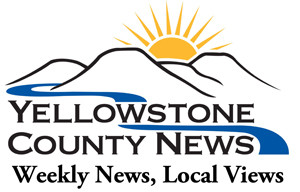by Evelyn Pyburn-Originally published in the Yellowstone County News.
LOCKWOOD — Proposed designs for roundabouts at the Johnson Lane Interchange and how they could impact Lockwood’s truck traffic was the primary topic of discussion at the Lockwood Business Group (LBG) meeting on Tuesday evening.
Concern that roundabouts could negatively impact the lifeblood of about half of Lockwood businesses quickly put the issue on the front burner for those attending one of the first meetings of the reorganized group. Roundabouts could hamper the ability of trucks to negotiate Lockwood streets, which could prompt truckers to stop elsewhere to refuel, and discourage transportation- based businesses from locating in Lockwood.
Dustin Bretz of Bretz RV reported on the research he did regarding the bypass project, saying he discovered that MDOT is further along in the planning process than what most people realize. Lockwood residents will have to act quickly to have any input on what is done, he said.
LBG members decided that no time should be lost in making sure that every business in Lockwood is aware of what is being proposed for the Billings Bypass. Special invitations will be sent to every Lockwood business that depends upon trucks to sustain their business, to attend a meeting sometime in January. Stefan Streeter, district manager for the MDOT, will be invited to speak and answer questions.
As part of the environmental impact study for the bypass, which was completed in 2014, MDOT has designed five different options of how to rebuild the interchange, which will be the Lockwood point of access to the proposed northend bypass. The proposed bypass, which will connect Lockwood to the north end of Main Street in the Heights, including a bridge across the Yellowstone River, is to begin construction in 2017. It will also connect Interstate Highways I-90 and I-94 more directly with State Highways 87 and 312.
Bretz said that he believes Lockwood has an uphill climb in opposing roundabouts. The fact that three of the five proposed designs include roundabouts may indicate that the agency’s preference is “heavily weighted” in favor of roundabouts, said Bretz. It was also noted that despite much opposition to roundabouts for the Shiloh Road project, they got roundabouts, nonetheless.
Bretz said that while roundabouts are probably a good alternative in handling residential traffic, they are not good for trucks, and putting them in Lockwood could spell disaster for the economic basis of the community.
Bretz RV is in the process of building a major hub for recreational vehicles on Old Hardin Road in Lockwood, and RVs can have just as much trouble negotiating roundabouts as do trucks, said Bretz, noting that two-thirds of all fifth-wheelers also tow a boat. Bretz RV chose to build their business expansion in Lockwood because of access to the interstate.
Comments from the 20-some members attending the LBG meeting underscored how seriously they viewed the threat. Lockwood is home to two major truck stops, a major refinery, several trucking transportation businesses, a variety of businesses which involve hauling various kinds of materials, warehouses and storage facilities, businesses that build truck trailers and large components for machinery, a truck wash and manufacturers of large products that must be hauled on trucks. In addition, much of Lockwood’s future growth is projected to be transportation businesses, warehouses and an industrial park, for which access to two major interstate highways is paramount.
“Have any of the design engineers ever been to Lockwood?” queried one businessman.
It was also questioned whether anyone in Lockwood was contacted regarding the development of the proposed designs.
The group discussed the pros and cons of each design. The three options with roundabouts propose from three to five roundabouts. One would include a super size roundabout that would circle beneath both lanes of Interstate 90 at Johnson Lane. One proposal with no roundabouts features a “double crossover diamond interchange” and another involves a combination of a crossovers and roundabouts.
The crossover design seemed intriguing to the business people and while it might work, it would probably be confusing to people unfamiliar with the area and that would include much of the truck traffic. The design directs traffic to “the wrong side of the street,” said Bretz, and would take some getting used to.
The business people were very sensitive to anything that would discourage truck drivers from driving further down the interstate. There are refueling options in communities like Columbus, they said, and if it looked like the prospects were good it would take no time at all for some business to build a truck stop at a less constraining intersection.
In other business, the members elected John McFerran, B & L Scales, as president, Bryce Glen, Rocky Mountain Compost, as vice president and Evelyn Pyburn, Yellowstone County News, as secretary.
Dan Carter with ExxonMobil reported on research he did regarding “Welcome to Lockwood” signage, a project that members said they wanted to pursue. Showing photos of the “Welcome to Billings” sign at the airport and of the Yellowstone Country Club sign, which is a similar concept, just much smaller, he said that Lockwood could do anything in between. Costs would vary as much as $50,000 to $8,000 or $9,000. The group needs to decide where to put the sign and how to fund it, he said.
“It needs to be a community decision,” he said.
Frosty Erben, a Lockwood real estate broker, said that he thought there should be two “Welcome to Lockwood” signs and said he thought they may be able to find the materials (rocks) near Lockwood for little or no cost.
It was suggested that if the LBG sustained itself as a significant organization, they could take on the task of maintaining the signs

